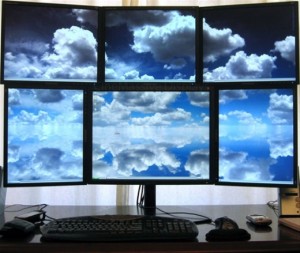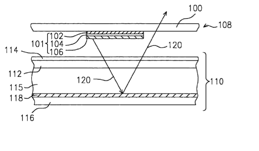LIQUID CRYSTAL DISPLAYS of LCDs
are pervasive amongst computer monitors and thread through a vast array of digital devices in the home and office. James Fergason and the International Liquid Crystal Company produced a LCD watch, igniting a burgeoning race of manufacturers with intense focus to overcome the obstacle of contrast to addressable rows. [2]
The architecture of an LCD display incorporates a liquid crystal solution between two sheets of polarizing material. Electricity excites the solution and herds the crystals to form patterns. Each crystals opaque or transparent consistency form displayed numbers and text. [2]
As seen in this image “ In this embodiment, the regional light source 108 is located on the liquid crystal display panel (110) to directly radiate a light thereon. The regional light source (108) includes a substrate (100) and a light-emitting structure (101). The substrate 100 includes a transparent material such as glass, while the light-emitting structure 101 includes an organic light emitting diode, for example.
The light-emitting structure 101 is disposed on one side of the substrate 100 to face the liquid crystal display panel 110. The light-emitting structure101is disposed on one side of the substrate 100 to face the liquid crystal display panel 110.
The light-emitting structure 101 includes a cathode 102, a luminescent layer 104 and an anode 106. The luminescent layer 104 is sandwiched between the cathode 102 and the anode 106. The material for forming the cathode 102 includes metal with good conductivity such as silver and aluminum. The luminescent layer 104 is made of luminescent organic material. The anode includes a transparent conductive material such as indium oxide (ITO).” [22]
Liquid Crystal Display researchers overcame the limitations of operating life, contrast ratio, high power consumption and viewing angle limitations.
With these progresses, the LCD replaced CRTs as the popular surface solution for electronic instruments. “However, despite its impressive performance, the conventional color transmissive LCD architecture employs a convoluted electro optical path…This complexity has stimulated the search for a more intuitively simple approach to making flat panel displays.”[18]
llllllllllllllllllllllllllllllllllllllllllllllllllllllllllllllllllllllllllllllllllllllllllllllllllllll


